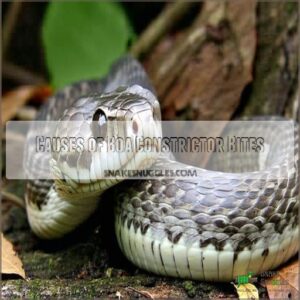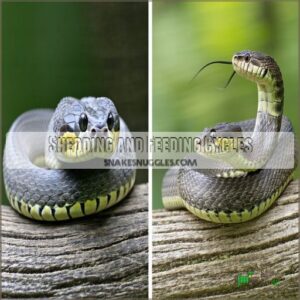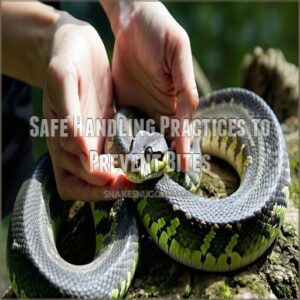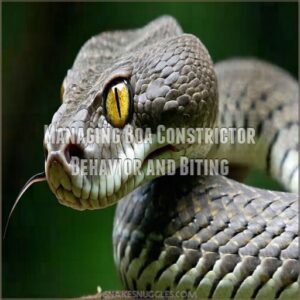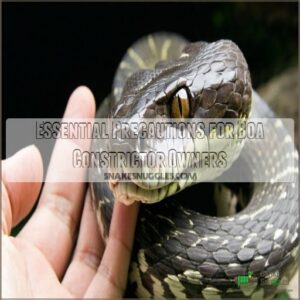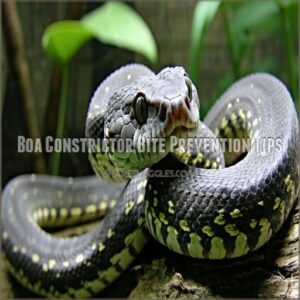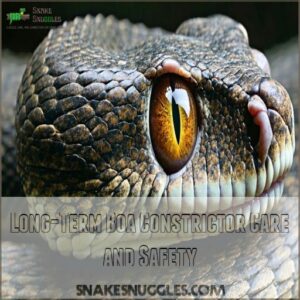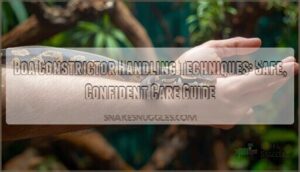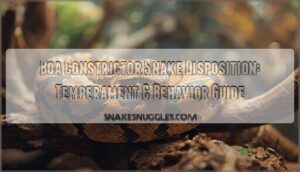This site is supported by our readers. We may earn a commission, at no cost to you, if you purchase through links.

Support your boa’s body weight properly and move with slow, deliberate actions – think tai chi rather than aerobics!
Keep their enclosure at the sweet spot of 78-82°F with 60-70% humidity, and provide plenty of hiding spots to reduce stress.
Watch for warning signs like hissing or tail vibration, which are your snake’s way of saying "back off!" Regular handling builds trust, but timing is everything – avoid contact during breeding season or when they’re in shed.
Understanding your boa’s body language is just the beginning of creating a bite-free bond. Understanding your boa’s body language is key to prevent boa constrictor bites.
Table Of Contents
- Key Takeaways
- Causes of Boa Constrictor Bites
- Recognizing Threat Cues and Behavior
- Safe Handling Practices to Prevent Bites
- Creating a Safe Environment for Boa Constrictors
- Building Trust With Your Boa Constrictor
- Pre-Bite Warning Signs and Prevention
- Managing Boa Constrictor Behavior and Biting
- Essential Precautions for Boa Constrictor Owners
- Boa Constrictor Bite Prevention Tips
- Long-Term Boa Constrictor Care and Safety
- Frequently Asked Questions (FAQs)
- Do boa constrictors bite?
- What is the cure for "no-see-um" bug bites?
- Is it safe to handle a boa constrictor?
- What to do if a boa bites you?
- How do you keep a boa constrictor away from a snake?
- What should I feed my boa constrictor?
- How to stop snakes from biting you?
- Why did my boa constrictor bite me?
- Is it safe to hold a boa constrictor?
- How to tell if a boa is about to strike?
- Conclusion
Key Takeaways
- You’ll prevent most bites by reading your boa’s warning signs: hissing, tail vibration, and defensive posturing signal stress or discomfort.
- You can build trust through consistent, gentle handling—keep sessions short (5–10 minutes), support the snake’s full body weight, and avoid sudden movements.
- You’ll need to maintain proper habitat conditions (78–82°F temperature, 60–70% humidity) and provide multiple hiding spots to reduce stress-related aggression.
- You shouldn’t handle your boa during vulnerable periods like shedding, after meals (wait 48–72 hours), or during breeding season when they’re more defensive.
Causes of Boa Constrictor Bites
You’ll find that most boa constrictor bites happen when these typically calm snakes feel threatened or stressed by improper handling techniques or environmental factors.
Your snake’s age, temperament, and your handling experience all play key roles in whether you’ll get a warning hiss or an unexpected bite during your interaction.
Factors Affecting Bite Severity
How severe will a boa constrictor bite be?
It’s like solving a puzzle where multiple pieces matter.
The bite location plays a key role – fingers and face are more sensitive than muscular areas.
Your handling skill and the snake’s size directly impact bite severity. Even your personal pain tolerance affects how you’ll experience it.
High stress levels in either you or your snake can worsen the situation.
Snake Age and Temperament
Your boa’s age and temperament play a major role in bite risk. Adult boas pack more punch with their bites, while younger snakes deliver what handlers playfully call an "angry toothbrush" sensation. Each boa has its unique personality, just like a furry pet.
- Juvenile boas (under 2 years) tend to be more defensive and quick to strike
- Adult boas show more predictable behavior patterns
- Feeding response aggression peaks during breeding season
- Stress-related strikes increase with improper housing conditions
Handling Technique and Experience
Handling boa constrictors safely requires more than just bravery – it demands proper technique and experience.
Beginner mistakes, like grabbing too quickly or using unsafe restraint methods, often lead to defensive bites.
Experienced handlers know that supporting the snake’s body weight and using appropriate handling tools can prevent stress-induced strikes.
Statistics show that most bites happen during improper handling, making proper training essential for safe boa constrictor interaction.
Recognizing Threat Cues and Behavior
You’ll notice clear warning signs before your boa constrictor attempts to bite, just like a grumpy teenager who needs space.
By learning to read your snake’s body language, including behaviors like hissing, tail vibration, and defensive posturing, you can prevent most bite incidents before they happen.
Hissing and Defensive Posture
A boa constrictor’s hiss serves as nature’s warning system, signaling stress or discomfort before defensive behaviors escalate.
When threatened, these snakes flatten their heads, coil their bodies tightly, and raise their upper bodies in a defensive posture.
Understanding these stress indicators is essential for bite prevention – if you spot these warning signs, step back and give your snake space to calm down.
Tail Vibration and Body Language
Before striking, boa constrictors display distinctive tail signals and body postures that serve as warning signs, much like corn snakes use tongue flicking signals. These defensive displays help predict potential bites if you know what to watch for.
- A rapidly vibrating tail indicates heightened stress and imminent defensive behavior
- S-shaped coiling with raised head indicates readiness to strike
- Tight muscle tension throughout the body indicates defensive positioning
Watch for these stress cues to prevent unwanted encounters.
Shedding and Feeding Cycles
Shedding and feeding cycles substantially impact a boa constrictor’s behavior.
During shedding, your snake’s vision becomes temporarily impaired, increasing bite risk. Watch for cloudy eyes and dull scales – signs that indicate it’s time to minimize handling.
After meals, wait 48-72 hours before any interaction, as post-feeding stress can trigger defensive responses.
Understanding these natural cycles helps prevent unwanted encounters and promotes responsible boa constrictor ownership.
Safe Handling Practices to Prevent Bites
You’ll find that mastering proper handling techniques is your best defense against boa constrictor bites, just like learning to dance with a partner who’s no legs.
When you handle your boa with confidence and respect while supporting its full body weight, you’ll dramatically reduce the chances of getting an unwanted love bite from your scaly friend.
Confident and Respectful Handling
Now that you know the warning signs, let’s talk about how you can safely handle your boa.
Think of it like dancing – your moves should be smooth and purposeful.
When you approach your boa, project quiet confidence through your body language awareness.
Before handling, make sure to wash your hands thoroughly with soap and water as part of proper handling preparations.
You’re not their predator or prey, just a calm, trusted partner.
Keep your movements slow and deliberate, avoiding any sudden gestures that might startle.
Supporting The Snake’s Body Weight
While handling your boa constrictor, proper weight distribution becomes your best friend. Think of your hands as living branches, giving your snake the support it needs to feel secure.
Here’s how to nail proper support:
- Keep both hands under the snake’s body, spaced about 1/3 of its length apart
- Create a gentle hammock with your palms facing upward
- Move your hands along as the snake glides, always maintaining contact
Avoiding Sudden Movements
A startled snake is a striking snake.
Quick movements can trigger your boa’s defensive instincts, so maintain slow, deliberate handling when interacting with your pet.
Make your actions predictable and calm, giving your boa time to process what’s happening. Patient interaction builds trust – think of it like approaching a shy friend.
When you move smoothly and deliberately, your boa’s more likely to stay relaxed. When you move smoothly and deliberately, your boa’s more likely to stay relaxed. Patient interaction builds trust.
Creating a Safe Environment for Boa Constrictors
You’ll need to create a secure home that meets your boa’s specific needs for temperature, humidity, and enrichment to prevent stress-related bites.
Just like you wouldn’t want to live in an uncomfortable house, your boa needs the right environment with proper hiding spots and climbing opportunities to feel safe and calm.
Secure Habitat and Enclosure
A secure boa constrictor enclosure is your first line of defense against bites.
Your snake’s home needs sturdy latches, proper ventilation, and adequate space – at least 6 feet long for adults.
Include multiple hide boxes and appropriate substrate type to help your boa feel safe. Think of it like building a cozy fortress: when your snake feels secure in its space, it’s less likely to bite. a secure boa constrictor enclosure. Your snake’s home
Proper Temperature and Humidity
Consistently maintaining proper temperature and humidity levels in your boa constrictor’s enclosure directly impacts their mood and bite risk.
Like a comfy home keeps you happy, your snake needs specific conditions to thrive.
Here’s what to monitor:
- Keep ambient temperature between 78-82°F with a 88-90°F basking spot
- Maintain humidity at 60-70% using quality substrate
- Monitor levels daily with reliable gauges
- Use proper heating equipment with thermostats
Enrichment and Hiding Places
A thoughtfully designed boa constrictor habitat needs multiple hiding spots and enrichment features.
Provide at least two hide boxes of different sizes, along with varied climbing structures and sturdy branches at different heights.
Visual barriers like plants or cork bark help reduce stress-induced aggression.
Smart substrate choices and strategic branch placement create a stimulating environment that keeps your boa feeling secure and less likely to bite.
Building Trust With Your Boa Constrictor
You’ll find that building trust with your boa constrictor isn’t much different from making friends with a shy neighbor – it takes patience, consistency, and respect for their personal space.
When you establish a trusting relationship through gentle, regular handling sessions, you’ll create a strong bond that reduces the risk of defensive bites and makes every interaction more enjoyable.
Regular Handling and Interaction
Regular interaction helps build trust with your boa constrictor, making handling safer and more enjoyable.
Start with short, 5-minute sessions three times weekly, gradually increasing duration as your snake shows comfort signals like relaxed muscles and curious tongue flicks.
Having the right equipment and setup in place, such as a suitable boa enclosure design, can also contribute to a comfortable environment for your snake.
Think of it like making a new friend – rushing things won’t help. Consistent positive reinforcement through gentle handling creates a foundation for a lasting, bite-free relationship.
Gentle and Gradual Handling
Building trust with your boa starts with gentle, patient handling sessions.
Think of it like getting to know a shy friend – you wouldn’t rush them into a bear hug on day one.
Start with short 5-10 minute sessions, letting your snake get comfortable with your presence. As your boa shows signs of relaxation, gradually extend handling time.
Remember, positive reinforcement goes a long way in fostering trust.
Avoiding Restraint and Stress
Many boa owners make the mistake of restraining their snakes, which triggers stress and defensive behavior.
Instead of forcing your boa’s movements, let it explore at its own pace. Create a calm environment with safe spaces where your snake can retreat when feeling overwhelmed.
Think of it like being a guide rather than a boss – gentle handling and positive reinforcement will prevent aggression and build lasting trust.
Pre-Bite Warning Signs and Prevention
You’ll spot clear warning signs before your boa constrictor decides to bite, including defensive hissing, rapid tail movements, and a tense, coiled posture.
By learning to read these signals and creating a stress-free environment, you’ll prevent most bites.
build a stronger bond with your scaly friend.
Recognizing Stress and Agitation
Your boa constrictor’s body language speaks volumes about its stress levels.
Watch for defensive postures like raised head position, tight coiling, or rapid tongue flicking. These stress signs often precede aggressive behavior.
Sharp hissing sounds, tail vibration, and sudden jerky movements are clear agitation cues that your snake feels threatened.
Understanding these boa constrictor behavior patterns helps prevent unwanted bites.
Avoiding Provocation and Threats
Now that you’re tuned into your boa’s stress signals, let’s look at what not to do.
Don’t tap on the glass, make sudden movements, or handle your snake during shedding or right after meals. These actions can trigger defensive responses.
Watch their body language – if they’re coiled tightly or hissing, back off. Remember, respectful handling means reading and responding to these warning signs. stress signals. defensive responses.
Providing a Stress-Free Environment
Creating a calm environment starts with proper habitat enrichment, such as using a thermostat reptile controller to maintain ideal temperatures (reptile temperature control).
Set up multiple hiding spots, maintain steady temperature control between 75-85°F, and keep humidity levels at 60-70%.
A spacious enclosure with climbing branches and substrate variety helps reduce stress in your boa constrictor.
Think of it like designing a cozy apartment – when they’re comfortable at home, they’re less likely to show aggressive behavior.
Managing Boa Constrictor Behavior and Biting
You’ll need to master your boa’s body language and behavior patterns to prevent unexpected bites, just like learning to read your best friend’s mood.
Understanding when your snake feels stressed, especially during shedding or after meals, will help you avoid those "grumpy snake moments" that could lead to a bite.
Understanding Snake Behavior and Body Language
Reading body language cues from a boa constrictor isn’t rocket science once you know what to watch for.
When calm, they’ll move smoothly with relaxed muscles and a gentle tongue flick.
Defensive postures include raised heads, tight coils, and quick jerky movements.
Stress indicators like frequent hiding or refusing food mean your snake needs space. Watch for these snake behavior cues to prevent unwanted encounters. Stress indicators and Defensive postures are important to understand.
Managing Shedding and Feeding Cycles
Managing your boa constrictor’s feeding schedule and shedding cycles is essential for bite prevention.
During shedding, your snake’s vision becomes impaired, making them more defensive and prone to striking. Wait 48 hours after feeding before handling to prevent regurgitation and potential bites.
Maintain proper hydration during shedding periods, and watch for signs of incomplete sheds that could affect their behavior and comfort level. Shedding cycles and bite prevention are important considerations.
Reducing Stress and Agitation
Keeping your boa constrictor calm and stress-free is essential for bite prevention. Your snake’s behavior reflects its environment and handling, so focus on gentle interaction and consistent routines.
- Set up habitat enrichment with multiple hiding spots and climbing opportunities
- Maintain regular feeding schedules to prevent food-related aggression
- Practice calm handling techniques, avoiding sudden movements
- Create a quiet environment away from loud noises and vibrations
- Monitor for signs of overstimulation like rapid tongue flicking or tense muscles
Essential Precautions for Boa Constrictor Owners
You’ll need to follow some essential safety rules to prevent your boa constrictor from biting, just like you’d need a seatbelt to drive safely.
While these fascinating creatures can make wonderful pets, you shouldn’t sleep with them or wrap them around your neck.
These risky behaviors account for most serious boa-related incidents.
Avoiding Unnecessary Handling
Three simple rules can drastically reduce your risk of boa constrictor bites: limit handling to essential tasks like cleaning, health checks, and brief socialization sessions.
Trust building happens gradually, so resist the urge to constantly handle your snake.
When you do interact, keep sessions short and focused. This patient, respectful approach minimizes stress and helps prevent defensive bites.
Sleeping With The Snake
Your bed might seem cozy to share with your boa constrictor, but co-sleeping poses serious safety concerns.
Nocturnal by nature, these snakes can become active while you sleep, potentially leading to accidental bites or constriction.
Even the most docile boa’s natural instincts can trigger during sleep, making shared beds a significant risk.
Keep your snake in its secure enclosure overnight for both your safety.
Placing The Snake Around Your Neck
While sleeping with your snake is risky, placing a boa constrictor around your neck takes danger to another level.
Despite looking cool in photos, neck-wrapping risks are serious – these powerful constrictors might bite if threatened or startled, leading to painful puncture wounds and potential infection risks from a boa constrictor bite.
Even typically calm boas might tighten their grip if startled, leading to choking hazards or circulatory issues.
Safe handling means keeping these impressive reptiles away from your neck.
Boa Constrictor Bite Prevention Tips
Smart handling practices act as your shield against boa constrictor bites, much like a well-orchestrated dance between keeper and snake. By understanding bite triggers and implementing stress reduction techniques, you’ll create a safer environment for both you and your serpentine companion.
For instance, recognizing your boa’s defensive behaviors, such as twitchy movements, a rigid body posture, hissing, and striking, as outlined in expert handling boa constrictor guidelines, is essential for a safe interaction.
Here are essential tips for boa constrictor bite prevention:
- Master safe handling techniques by supporting your boa’s entire body weight and avoiding sudden movements that might startle them
- Learn to read your snake’s body language, watching for signs of stress like tight coiling or rapid tongue flicking
- Maintain proper habitat safety with secure enclosures and appropriate temperature gradients
- Schedule handling sessions during your boa’s most active periods, avoiding the 48 hours after feeding
- Practice owner education by staying updated on the latest boa constrictor care guidelines and bite avoidance strategies
Remember, consistency in these practices helps avoid boa constrictor bites and builds trust with your pet.
Long-Term Boa Constrictor Care and Safety
You’ll need to master three key areas for safe, long-term boa constrictor care: ongoing education about your snake’s behavior, regular vet check-ups, and maintaining the right habitat conditions.
While it might seem like a lot to remember, you’ll find that these safety practices become second nature as you build a strong bond with your scaly friend through consistent, proper care.
Ongoing Education and Research
Keeping up with boa constrictor bite prevention means staying connected to the latest venom research and handling studies, and recognizing that most documented bites occurred during feeding, as shown in Snake Bite Statistics.
Join reptile forums, attend workshops, and follow expert channels to understand stress factors affecting your snake’s behavior.
| Resource Type | Benefits | Action Steps |
|---|---|---|
| Online Forums | Real-time advice | Join 2-3 active communities |
| Research Papers | Latest bite statistics | Set Google Scholar alerts |
| Expert Workshops | Hands-on training | Attend quarterly sessions |
| Social Media | Daily tips | Follow verified experts |
Regular Veterinary Check-Ups
Regular check-ups with a reptile vet form the backbone of responsible boa constrictor ownership.
Schedule visits every 6 months for preventative care and disease detection.
Your vet will check for parasites, assess injuries, and create customized wellness plans.
Think of these visits like your snake’s spa day – they’ll catch potential health issues before they turn into bigger problems. Plus, you’ll learn proper handling techniques to prevent future bites.
Ensuring a Safe and Healthy Environment
A well-designed habitat is your boa’s fortress of solitude.
Your enclosure safety checklist should include proper temperature control (75-85°F), stable humidity levels (60-70%), and strategic hiding spots.
Think of habitat enrichment as your snake’s personal playground – branches for climbing, caves for exploring, and substrate for burrowing.
This preventative approach to boa constrictor safety substantially reduces stress-related aggression and potential bites.
Frequently Asked Questions (FAQs)
Do boa constrictors bite?
Yes, boa constrictors can bite, but they’re not venomous.
You’ll feel pain and might get puncture wounds from their sharp teeth.
Most bites happen when they’re stressed, scared, or being handled incorrectly.
What is the cure for "no-see-um" bug bites?
You can treat no-see-um bites using calamine lotion, hydrocortisone cream, or an antihistamine to reduce itching.
Applying a cold compress and keeping the area clean helps speed up healing and prevent infection.
Is it safe to handle a boa constrictor?
Despite only one recorded human death from constriction, handling a boa requires proper techniques and respect.
It’s safe when you’re confident, avoid sudden movements, and support their body weight.
while recognizing threat signals like hissing.
What to do if a boa bites you?
Immediately clean the bite with soap and water.
Control bleeding with direct pressure, and seek medical attention.
Remove any embedded teeth with tweezers, apply antibiotic ointment, and monitor for infection signs.
How do you keep a boa constrictor away from a snake?
Like oil and water, boas and snakes don’t mix naturally.
Keep them in separate enclosures with secure lids.
Maintain proper temperatures, and never house different snake species together to prevent territorial conflicts.
What should I feed my boa constrictor?
Feed your boa constrictor appropriately-sized mice or rats every 7-14 days.
Young boas need smaller prey weekly, while adults can eat larger rodents less frequently.
Always provide fresh, thawed frozen prey.
How to stop snakes from biting you?
Handle your snake gently with calm, confident movements, avoiding sudden actions that might startle it.
Support its body weight properly.
Don’t handle during shedding or right after meals to prevent defensive bites.
Why did my boa constrictor bite me?
Your boa constrictor might’ve bitten you because it felt threatened, stressed, or mistook you for prey.
Common triggers include sudden movements, rough handling, feeding time confusion, or the snake’s shedding period.
Is it safe to hold a boa constrictor?
Like a dance with a graceful partner, holding a boa constrictor can be safe when you’re confident, calm, and follow proper handling techniques.
Support their body weight,
avoid sudden movements, and respect their space.
How to tell if a boa is about to strike?
Watch for defensive signs: coiled posture, raised head, hissing sounds, rapid tail movement, or tightened muscles.
A stressed boa may also display flattened body shape and retract its head before striking.
Conclusion
Mastering boa constrictor bite prevention isn’t just about following rules—it’s about building a relationship with your scaly friend.
By understanding their body language, maintaining proper habitat conditions, and handling them with confidence and respect, you’ll create a strong bond that makes bites rare.
Remember, each snake has its own personality, so stay patient and attentive. With these expert tips in mind, you’re well-equipped to enjoy a safe, rewarding experience with your boa constrictor companion. a safe, rewarding experience. boa constrictor bite prevention

